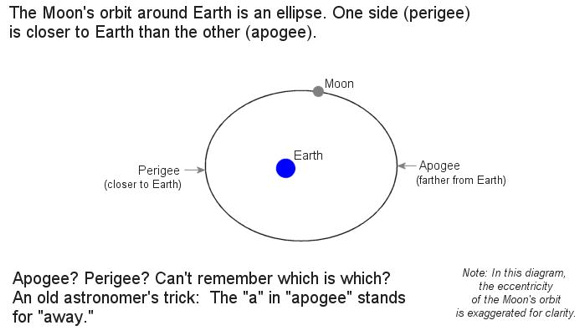November 14 presents the moon’s closest encounter with Earth in over 68 years, since January 26, 1948. The full moon on November 14, 2016, will feature the closest full moon (356,509 kilometers) until November 25, 2034 (356,448 kilometers).
What is a Supermoon?
A supermoon is the coincidence of a full moon or a new moon with the closest approach the Moon makes to the Earth on its elliptical orbit, resulting in the largest apparent size of the lunar disk as seen from Earth.
The Moon’s distance varies each month between approximately 357,000 kilometers (222,000 mi) and 406,000 km (252,000 mi) due to its elliptical orbit around the Earth (distances given are center-to-center).
The Supermoon of Nov 14, 2016
On November 14, 2016, the moon will be closer to Earth than it’s been since January 26, 1948. It’ll be a full moon and a supermoon. The moon won’t come this close again until November 25, 2034. That makes upcoming full moon the closest and largest supermoon in a period of 68 years!
Getting Technical on Supermoon
The term supermoon is relatively new. Before we called them supermoons, we in astronomy called them perigean full moons.
Moon is closest to Earth at perigee and farthest away at apogee. When the full moon aligns with perigee – as it does on November 14, 2016 – it’s a perigee full moon or supermoon. By the way, the moon’s orbit is much closer to being a circle than this diagram suggests.
Closest moon is nearly always a full moon?
Because of gravity, and the intriguing interplay of the sun, Earth and moon (and, to a lesser extent, the planets), the closest perigee of any given year is often the one that aligns most closely with full moon.
For the moon to appear full, the sun, Earth and moon need to be aligned, with Earth in the middle. During that particular alignment, the tidal pull of the sun and moon combine to create wide-ranging spring tides. And full moons at perigee create even wider-ranging perigean spring tides.
The diagram below helps to explain why the perigee full moon comes especially close to Earth. Take a careful look. Explanation below.
On the diagram above, the line connecting lunar perigee with lunar apogee defines the moon’s major axis (the longest axis of an ellipse).
When the moon’s major axis (apogee-perigee line) points sunward (A & C on the diagram), the eccentricity (flatness) of the moon’s orbit is increased to a maximum. A greater eccentricity lessens the perigee distance, while increasing the apogee distance.
At A in the diagram, it’s a perigee new moon (supermoon) and an apogee full moon (micro-moon).
Then 3.5 lunar months (some 103 days) later, at B in the diagram, the major axis is at a right angle to the sun-Earth line, so the eccentricity is minimal. At such times, the moon’s orbit is closest to circular. It’s a more distant perigee and closer apogee, with the first quarter and last quarter moons more or less aligning with apogee and perigee.
Then 7 lunar months (206 days) later, the major axis again points sunward. Once again, the eccentricity of the moon’s orbit is increased to a maximum, lessening the perigee distance yet increasing the apogee distance. This time around, it’s a full moon perigee and new moon apogee. See C in the diagram.
And don’t miss it.


